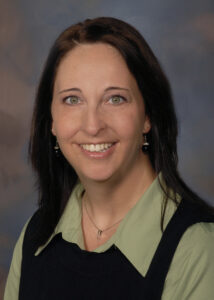With regard to rheumatology specifically, the ACR estimates that by 2030 the U.S. demand will be 8,184 clinicians, but the supply is expected to only be 3,455 clinicians.4
According to the AANP, “as care responsibilities shift, NPs and physician associates will handle the large majority of chronic disease management. This evolution in care delivery offers an important opportunity to evaluate the current chronic disease management delivered by NPs and to develop and evaluate NP education to improve upon that care.”3
A Personal Road

Ms. Durkee
Ms. Durkee’s journey to becoming an NP was a winding one. She first pursued a bachelor’s degree in family and human development, with an emphasis in marriage and family relations, and then a social service worker license in Utah. After spending seven years providing behavior-modification and mental health services to children, and watching what she described as “a decline in access to mental healthcare,” she became interested in pursuing a different direction and shifted toward nursing.
As Ms. Durkee earned her degrees as a licensed practical nurse and then a registered nurse, she began working in a short stay/observation unit at Primary Children’s Hospital, Salt Lake City. “I spent some of my time giving infusions to kids for a variety of conditions, including [rheumatic] diseases,” she says. “I really liked that because I was learning about the medications, interacting with physicians and seeing the kids at very set intervals, which allowed me to provide patient care while also developing relationships with the young patients and their families over time.”
Just as she started to think about options beyond hospital shift work, a friend mentioned nurse practitioner school and right away, she says, “It felt right.”
Typically, students entering NP programs are already practicing RNs, so she was ready on that front. While not all states require a Bachelor of Science in Nursing for admission, Ms. Durkee’s home state of Utah did, so she headed back to college to meet that qualification. Once in the NP program, she went through considerable advanced clinical training. After graduating, she passed a national board exam to finally hold the title of certified nurse practitioner.
With her training complete in 2012, Ms. Durkee accepted an NP position in rheumatology as an employee with the University of Utah, Salt Lake City, working out of the Intermountain Healthcare facilities in Salt Lake City, Riverton and Layton. It was a good fit then and remains a good fit now—more than 10 years later, she says. “We really have a cohesive team. I love what I do, and I feel like I make a difference every single day.”
